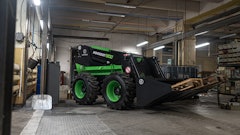
Many US military facilities and other government buildings include a “SCIF” a Sensitive Compartmented Information Facility. A SCIF is an enclosed area within a building where certain types of classified information, called Sensitive Compartmented Information (SCI) is processed, stored, used, or discussed. Access to a SCIF is normally limited to personnel with the appropriate security clearance, to ensure the highest level of protection for the sensitive information contained within.
A SCIF may be permanent or temporary; a temporary SCIF is often used to brief military officials while they are traveling. The White House Situation Room (AKA John F. Kennedy Conference Room) is an example of a permanent SCIF, located in the basement of the West Wing of the White House. In this area, the president of the United States and their advisors can monitor and communicate secure information about crises around the world.
Technical Specifications for Sensitive Compartmented Information Facilities (SCIF)
The complete physical and technical security requirements for SCIFs are detailed in a document from the National Counterintelligence and Security Center called “Technical Specifications for Construction and Management of Sensitive Compartmented Information Facilities” (IC Tech Spec – for ICD/ICS 705). The most recent edition of this publication is Version 1.5, published March 13, 2020. This document establishes requirements for three types of SCIF perimeter doors: primary doors (main entrance doors), secondary doors (entry and egress doors that are not the primary doors), and emergency egress-only doors (exit doors with no entry capability).
All SCIF perimeter doors are required by this document to comply with the applicable building code, life safety, and accessibility requirements as determined by the Authority Having Jurisdiction (AHJ). When wood doors are used, they must be 1 ¾-inch-thick solid core doors (i.e. wood stave, structural composite lumber). Steel doors must be 1 ¾-inch-thick, 18-guage, minimum, with hardware reinforcements of the specified gauges.
Additional requirements include door closers without the hold-open feature, installed on the SCIF side of the door, and non-removable hinge pins when doors are outswinging. Some SCIF doors are required to meet acoustic requirements or to incorporate a vestibule. Alarm requirements for SCIF perimeter doors are detailed in Chapter 7 of the technical specifications, and there are also shielding requirements that apply to some SCIF perimeter doors.
Federal Specification FF-L-2890
The technical specifications require locks that comply with the most current version of Federal Specification FF-L-2890, which details the requirements for the locking hardware on doors to these high-security rooms. The first edition of this specification was published in 1997, with revisions published in 2004 (FF-L-2890A), 2012 (B), and most recently in 2019 (C). Based on the early editions of this specification, a SCIF door was often equipped with locks that required two operations to unlatch the door for egress. However, beginning with the 2012 edition (FF-L-2890B) locks on normally occupied rooms have been required to comply with the model codes and referenced standards, including:
- International Building Code (IBC)
- International Fire Code (IFC)
- NFPA 101 – Life Safety Code
- NFPA 80 – Standard for Fire Doors and Other Opening Protectives
- ADA Standards for Accessible Design
- ICC A117.1 – Accessible and Usable Buildings and Facilities
- Uniform Federal Accessibility Standards (UFAS)
This change represented a step forward in life safety, fire protection, and accessibility, without sacrificing security. In addition to being listed for use on fire door assemblies (where required), compliance with these codes and standards ensures that doors serving these rooms can be unlatched with one motion for egress, with releasing hardware that is located between 34 inches and 48 inches above the floor. The hardware must be operable with one hand from the egress side with no tight grasping, pinching, or twisting of the wrist, and with no key, tool, special knowledge or effort.
Hardware Types
These requirements for code-compliance were carried forward into the 2019 edition of the federal specification (FF-L-2890C), which is called “Lock Extensions (Pedestrian Door Lock Assembly Preassembled, Panic, and Auxiliary Deadbolt).” This 30-page standard details the types of locks required for primary and secondary doors, which are divided into 10 hardware types:
Hardware for Primary Entrance Doors
- Type I – Lockset (PDPL) with mechanical or electronic stand-alone access control (i.e. keypad with a minimum 4-digit combination) – ANSI/BHMA A156.2 Grade 1, with electromechanical combination lock (FF-L-2740)
- Type II – Lockset (PDPL) with the capability of being used with building access control system, fail secure – ANSI/BHMA A156.2 Grade 1, with electromechanical combination lock (FF-L-2740)
- Type III – Panic hardware/fire exit hardware (PDLAP), rim type, with mechanical or electronic stand-alone access control (i.e. keypad with a minimum 4-digit combination) – ANSI/BHMA A156.3 Grade 1 Type I, with electromechanical combination lock (FF-L-2740)
- Type IV – Panic hardware/fire exit hardware (PDLAP), rim type, with the capability of being used with the building access control system, fail secure – ANSI/BHMA A156.3 Grade 1 Type I, with electromechanical combination lock (FF-L-2740)
- Type V – Deadbolt (ADB) – ANSI/BHMA A156.36 Grade 1, with electromechanical combination lock (FF-L-2740) and escape mechanism extension with an automatic life safety device with keyed reset function
- Type VI – Deadbolt (ADB) – ANSI/BHMA A156.36 Grade 1, with electromechanical combination lock (FF-L-2740) and escape mechanism extension with a manually operated life safety device
Hardware for Secondary Entrance Doors
- Type VII – Lockset (PDPL) with the capability of being used with building access control system, fail secure – ANSI/BHMA A156.2 Grade 1, with integral deadbolt and thumbturn
- Type VIII – Panic hardware/fire exit hardware (PDLAP), rim type, with the capability of being used with the building access control system, fail secure – ANSI/BHMA A156.3 Grade 1 Type I, with integral deadbolt and thumbturn
Hardware for Emergency Egress Only Doors
- Type IX – Lockset (PDPL) with integral deadbolt – ANSI/BHMA A156.2 Grade 1
- Type X – Panic hardware/fire exit hardware (PDLAP), rim type, with integral deadbolt – ANSI/BHMA A156.3 Grade 1 Type I
Hardware types V and VI are intended to be used on doors that are not part of a required egress route and are not required to be operable with one hand and a single motion to unlatch the door for egress. These locks would typically be used on unoccupied rooms such as telecommunications closets. The remaining hardware types (I through IV and VII – X) are required to comply with the codes and standards referenced above, in addition to the applicable BHMA standards.
The final pages of Federal Specification FF-L-2890C include conceptual drawings of each hardware type. Products that meet the requirements of this specification are listed in the Qualified Products List QPL-FF-L-2890-2, dated September 17, 2018 (supersedes QPL-FF-L-2890-1 dated September 1, 2015). For more information about these specifications and products, consult the manufacturers referenced in the QPL document.
Abbreviations used in this article:
FF-L-2890 Hardware Types
- PDPL – Pedestrian Door Preassembled Locks – locks used on fire doors and non-labeled doors as the only locking devices
- PDLAP – Pedestrian Door Lock Assemblies Panic – panic hardware or fire exit hardware where required for assembly occupancies
- ADB – Auxiliary Door Deadbolts – deadbolts used for security – typically on rooms that are not normally occupied
FF-L-2740 is a federal specification for electromechanical combination locks
This article originally ran on https://idighardware.com/


























